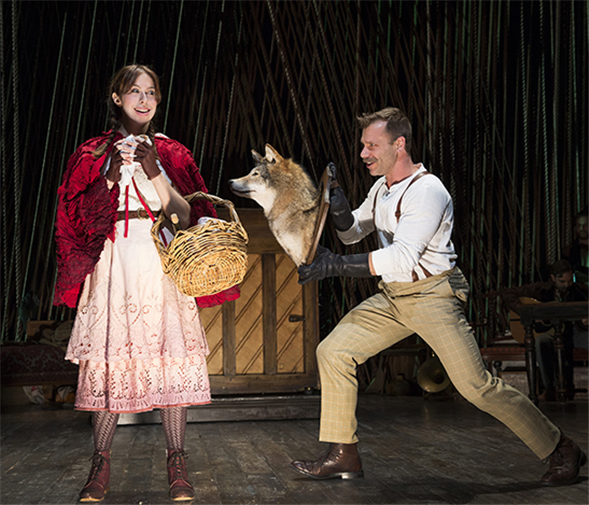By LINDA BUCHWALD
In Fiasco Theater's production of
Into The Woods, now at Roundabout's Laura Pels Theater, the handle of a suitcase flopping back and forth can make music. So can the chime of a grandfather clock.
This scaled-down production of Stephen Sondheim's 1987 musical, which follows a group of fairy tale characters past the end of their traditional stories, uses only ten actors and a pianist. That's a stark contrast to the larger-than-life version currently playing in movie theatres, and to create a sense of the lush score, orchestrators Matt Castle and Frank Galgano had to get creative.
Even the set, designed by Derek McLane, is an instrument. It looks like the inside of a piano, but it's easy to imagine that the strings are trees in a magical wood. There are piano harps taken from real pianos on the walls, tuned by sound designer Darron West and used in the show to create sound effects.
Meanwhile, Castle, who is also the production's musical director and pianist, wrote his orchestrations around whatever instruments the cast members could play. For example, Paul L. Coffey (Mysterious Man) plays cello, Liz Hayes (Cinderella's Stepmother, Jack's Mother) plays bassoon, and Ben Steinfeld (Baker, co-director) plays guitar, so Castle made sure to incorporate all those sounds. "Every aspect of the show feels like it's coming from what the actors do best," he says. "That's ideally what we're shooting for."
In rehearsals for the original run at the McCarter Theater in May 2013, Castle would see which performers were not being used in each scene. (When Fiasco brought the production to San Diego's Old Globe Theater last summer, Galgano, Castle's husband, joined the creative team as co-orchestrator.) If someone was sitting to the side, he might jot something out on scratch paper for that actor to play. "They'd look at it, see if it worked, and we would build it together," he says.
Other decisions are rooted in what will be most satisfying for the audience. Castle explains, "Instead of, 'And grandma played a tambourine,' we do a song that really reaches a climax and has a full, gratifying effect."
For instance, in "Last Midnight," an eleven o'clock number belted by the Witch, actors bang on the walls, getting faster and scarier as they go. For "Hello Little Girl," the Wolf's seductive entreaty to Little Red Riding Hood, Castle went for a more bluesy feel: "The Wolf is confessing to the audience how hungry he is to eat that little girl. He's like a sleazy guy in an alley somewhere in a trench coat singing his nasty wolf song."
Some things may sound substantially different to those familiar with the original Broadway cast recording, like the moment when Cinderella visits her mother's grave. Traditionally, one actress sings as Cinderella's mother, but in this production, four women sing in harmony.
"Frank and I made up that vocal harmony, but the melody that Steve wrote is still there," Castle says. "It's just elaborated."
They were able to do this because Sondheim and original director/book writer James Lapine gave Fiasco permission to experiment with the score, as long as they did not use any part of Jonathan Tunick's original orchestrations. Castle says, "That is perfectly reasonable because an orchestration isn't something you can dismantle and use the parts you like. You either use the whole thing, or you don't use any of it at all."
These new orchestrations, he adds, make the show feel particular suited to this company, which enhances the audience's connection to the performers.
"Having the same actor play Rapunzel and Little Red Riding Hood and be a narrator in the show, you start to feel like you understand who Emily Young is," Castle says. "You're not just looking at Little Red Riding Hood. You're looking at Emily herself. If I'm connecting to the person telling the story, that changes my relationship to the story itself. I'm not just hearing the story of Little Red Riding Hood. I'm hearing my friend Emily tell me the story of Little Red Riding Hood. I think it's a really beautiful and intimate experience."
---
Linda Buchwald tweets about theatre as @PataphysicalSci
Photos by Joan Marcus
